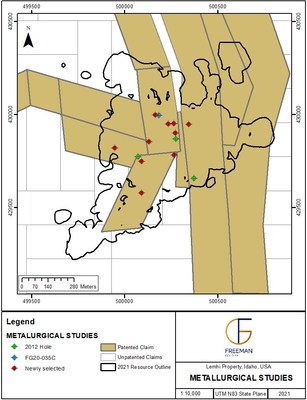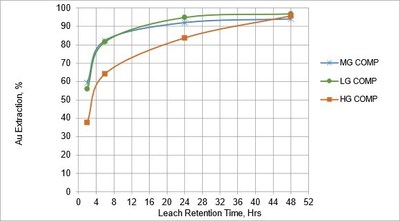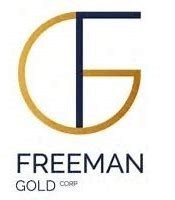Freeman Gold Reports >95% Gold Recoveries in Initial Metallurgical Testing for the Lemhi Gold Project
Freeman Gold Corp. (CSE: FMAN, OTCQB: FMANF) has announced encouraging results from metallurgical testing of its Lemhi Gold Project in Idaho, achieving gold recoveries exceeding 95% across various head grades (0.4 to 2.1 g/t Au). The tests indicate potential recoveries of up to 98% using cyanide tank leaching methods. Ongoing studies will further confirm these results and support future economic evaluations. The 2021 metallurgical program, conducted by SGS Mineral Services, aims to optimize processing conditions and assess the project's viability for production.
- Gold recoveries exceed 95% in initial testing.
- Potential recoveries of up to 98% through tank leaching.
- Consistent results across various head grades demonstrate reliability.
- Ongoing testwork aims to confirm recoveries over broader areas for economic studies.
- None.
Insights
Analyzing...
- Conventional tank leach processing achieves recoveries up to
98% - Leach response and recoveries consistent over wide spatial area, depth and head grades
- Continuing testwork to confirm recoveries over larger spatial area ahead of economic studies
CANADIAN SECURITIES EXCHANGE: FMAN
VANCOUVER, BC, Oct. 5, 2021 /PRNewswire/ - Freeman Gold Corp. (CSE: FMAN) (OTCQB: FMANF) (FSE: 3WU) ("Freeman" or the "Company") is pleased to report results from initial metallurgical testing on drill core material from its Lemhi Gold Project in Idaho. The test work has shown consistently high gold extractions exceeding
"We are extremely pleased with the initial metallurgical results," commented Paul Matysek, Executive Chairman. "The metallurgical results to date suggests that the oxide zone potentially continues at depth. This bodes well for the discovery of additional oxide material along strike and below the current resource."
The gold processing plan was developed and supervised by independent consulting metallurgist Mr. Frank Wright, P.Eng., of F. Wright Consulting Inc. Mr. Wright is a professional engineer and Qualified Person as defined by National Instrument 43-101 with over 25 years experience in the fields of mineral processing and hydrometallurgy. He has been principally involved in formulating the process philosophy and related flowsheet development that are suitable for advancing mineral projects into full economic evaluation. This has included studies for a variety of producers and exploration companies globally in the precious and base metal mining industry over the last three decades.
Mr. Wright states that, "The leach response at Lemhi has consistently, over a wide spatial area and grade range of the resource, provided gold recoveries in the mid to upper
2021 Metallurgical Program
Freeman's 2021 metallurgical program consisted of two phases and was performed by SGS Mineral Services of Burnaby BC ("SGS"). The program ran tests on fourteen intervals and composites obtained from archived assay rejects originating from 2012 diamond drill core (Phase 1) and from two 2020 PQ diamond drill core intervals (Phase 2). These samples were used for both comminution and leach studies. The drill holes selected are distributed over a significant area of the resource and include samples at depths of 202 metres below surface (Figure 1). Figure 1 also includes drill holes selected for further metallurgical test work.
As further described in the Company's press release dated January 19, 2021, historical metallurgical test work had been performed in the 1990s by Kappes Cassiday and Associates, of Reno, Nevada. This work primarily focused on column leach testing to evaluate the merits of a heap leach facility. It resulted in an overall gold recovery averaging
Given the results of the historical testing, the bulk of the 2021 metallurgical program was directed primarily to evaluate tank leach procedures, suitable to carbon in pulp (CIP) treatment. This extractive process was pursued due to Lemhi's coarse grain gold component and overall higher gold grade nature as compared to a typical heap leach operation. CIP is well suited to deposits of this type in higher gold price environments. Heap leach is still being considered an option for lower grade materials.
SGS laboratory findings to date indicate that over a range of potential mill feed grades gold recovery from tank leaching ranges between
Pre-treatment of the leach feed by centrifugal gravity concentration suggests one-third or more of the gold present may be recovered into an uncleaned gravity concentrate, suitable for intense cyanidation. This is relevant given the corresponding head grades indicate a significant portion of gold occurs as coarse particles.
Cyanide bottle roll testing was initially performed on archived 2012 assay rejects at various particle sizes. Leach conditions adjusted pH with lime to pH 10.5, maintaining 1.5 g/L NaCN to start and operated for up to 48 hours. Various grind particle size were tested between
The kinetic curves in Figure 2 suggest a leach retention time of approximately 36 hours is appropriate, although higher grade samples may benefit from extended leach times. A similar test was performed for composites derived from the 2020 drill core which resulted in
Preliminary laboratory data also suggests that sulphide bearing material, including pyrite or chalcopyrite intervals, could produce a potentially marketable flotation concentrate containing gold, along with flotation tailing suitable for CIP. This may become important should future exploration identify a resource in oxide transition into sulphide materials at depth.
Further metallurgical test work (Phase 3) is slated to begin later this month at SGS on a further 27 composites of assay rejects. These rejects were obtained from split drill core intervals from the 2020 exploration program and average ~4-5 m in length to represent wide spatial areas and depths of the existing resource. These variability studies will help optimize process conditions for tank leaching and provide sufficient data in support of the undertaking of a preliminary economic evaluation of the project.
About the Company
Freeman Gold Corp. is a mineral exploration company focused on the development of its
On Behalf of the Company
William Randall
President & CEO
Forward Looking Statements: This press release contains "forward–looking information or statements" within the meaning of Canadian securities laws, which may include, but are not limited to statements relating to its future business plans. All statements in this release, other than statements of historical facts, that address events or developments that the Company expects to occur, are forward-looking statements. Forward-looking statements are statements that are not historical facts and are generally, but not always, identified by the words "expects," "plans", "anticipates", "believes", "intends", "estimates", "projects", "potential" and similar expressions, or that events or conditions "will", "would", "may", "could" or "should" occur. Although the Company believes the expectations expressed in such forward-looking statements are based on reasonable assumptions, such statements are not guarantees of future performance and actual results may differ from those in the forward-looking statements. Such forward-looking information reflects the Company's views with respect to future events and is subject to risks, uncertainties, and assumptions. The Company does not undertake to update forward–looking statements or forward–looking information, except as required by law.
Neither the Canadian Securities Exchange nor its regulation services provider accepts responsibility for the adequacy or accuracy of this release.
![]() View original content to download multimedia:https://www.prnewswire.com/news-releases/freeman-gold-reports-95-gold-recoveries-in-initial-metallurgical-testing-for-the-lemhi-gold-project-301392616.html
View original content to download multimedia:https://www.prnewswire.com/news-releases/freeman-gold-reports-95-gold-recoveries-in-initial-metallurgical-testing-for-the-lemhi-gold-project-301392616.html
SOURCE Freeman Gold Corp.










